
Question Number 2454 by Yozzi last updated on 20/Nov/15
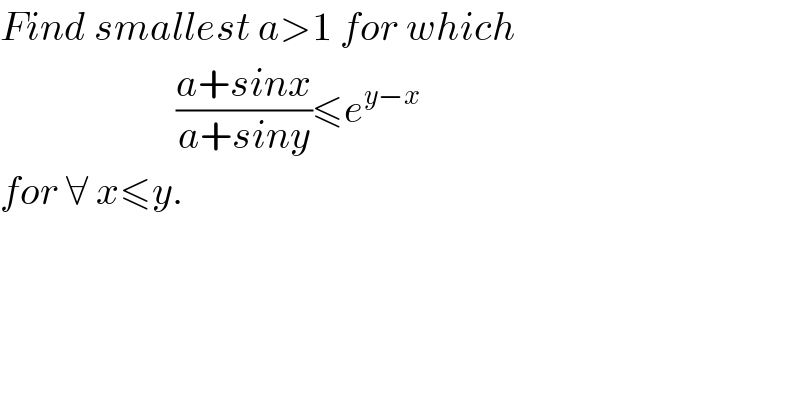
$${Find}\:{smallest}\:{a}>\mathrm{1}\:{for}\:{which} \\ $$ $$\:\:\:\:\:\:\:\:\:\:\:\:\:\:\:\:\:\:\:\:\:\:\frac{{a}+{sinx}}{{a}+{siny}}\leqslant{e}^{{y}−{x}} \\ $$ $${for}\:\forall\:{x}\leqslant{y}. \\ $$
Commented byRasheed Soomro last updated on 21/Nov/15
![Find smallest a>1 for which ((a+sinx)/(a+siny))≤e^(y−x) for ∀ x≤y. −−−−−−−−−−− ((a+sin x)/(a+sin y))≤e^(y−x) a+sin x≤e^(y−x) (a+sin y) ≤ae^(y−x) +e^(y−x) sin y a−ae^(y−x) ≤e^(y−x) sin y −sin x a(1−e^(y−x) )≤e^(y−x) sin y −sin x a≤((e^(y−x) sin y −sin x)/(1−e^(y−x) )) assuming y>x [for y=x see sec A] Since a>1 1<a≤((e^(y−x) sin y −sin x)/(1−e^(y−x) )) a=Smallest ((e^(y−x) sin y −sin x)/(1−e^(y−x) ))>1 We have to use such values of x and y for which_(−) ((e^(y−x) sin y −sin x)/(1−e^(y−x) )) is smallest but greater than 1_(−) For y=x............................section A ((a+sinx)/(a+siny))≤e^(y−x) ((a+sin x)/(a+sin x))≤e^(x−x) 1≤1 No help for a Continue](Q2461.png)
$${Find}\:{smallest}\:{a}>\mathrm{1}\:{for}\:{which} \\ $$ $$\:\frac{{a}+{sinx}}{{a}+{siny}}\leqslant{e}^{{y}−{x}} \\ $$ $${for}\:\forall\:{x}\leqslant{y}. \\ $$ $$−−−−−−−−−−− \\ $$ $$\:\frac{{a}+{sin}\:{x}}{{a}+{sin}\:{y}}\leqslant{e}^{{y}−{x}} \\ $$ $${a}+{sin}\:{x}\leqslant{e}^{{y}−{x}} \left({a}+{sin}\:{y}\right) \\ $$ $$\:\:\:\:\:\:\:\:\:\:\:\:\:\:\:\:\:\:\leqslant{ae}^{{y}−{x}} +{e}^{{y}−{x}} {sin}\:{y} \\ $$ $${a}−{ae}^{{y}−{x}} \leqslant{e}^{{y}−{x}} {sin}\:{y}\:−{sin}\:{x} \\ $$ $${a}\left(\mathrm{1}−{e}^{{y}−{x}} \right)\leqslant{e}^{{y}−{x}} {sin}\:{y}\:−{sin}\:{x} \\ $$ $${a}\leqslant\frac{{e}^{{y}−{x}} {sin}\:{y}\:−{sin}\:{x}}{\mathrm{1}−{e}^{{y}−{x}} }\:\:\:\:\:\:{assuming}\:{y}>{x}\:\left[{for}\:{y}={x}\:{see}\:{sec}\:{A}\right] \\ $$ $${Since}\:{a}>\mathrm{1} \\ $$ $$\mathrm{1}<{a}\leqslant\frac{{e}^{{y}−{x}} {sin}\:{y}\:−{sin}\:{x}}{\mathrm{1}−{e}^{{y}−{x}} } \\ $$ $${a}={Smallest}\:\frac{{e}^{{y}−{x}} {sin}\:{y}\:−{sin}\:{x}}{\mathrm{1}−{e}^{{y}−{x}} }>\mathrm{1} \\ $$ $$\underset{−} {{We}\:{have}\:{to}\:{use}\:{such}\:{values}\:{of}\:{x}\:{and}\:{y}\:{for}\:{which}} \\ $$ $$\underset{−} {\frac{{e}^{{y}−{x}} {sin}\:{y}\:−{sin}\:{x}}{\mathrm{1}−{e}^{{y}−{x}} }\:{is}\:{smallest}\:{but}\:{greater}\:{than}\:\mathrm{1}} \\ $$ $${For}\:{y}={x}............................{section}\:{A} \\ $$ $$\:\frac{{a}+{sinx}}{{a}+{siny}}\leqslant{e}^{{y}−{x}} \\ $$ $$\:\frac{{a}+{sin}\:{x}}{{a}+{sin}\:{x}}\leqslant{e}^{{x}−{x}} \\ $$ $$\mathrm{1}\leqslant\mathrm{1}\:\:\:\:{No}\:{help}\:{for}\:{a} \\ $$ $${Continue} \\ $$
Commented byprakash jain last updated on 20/Nov/15
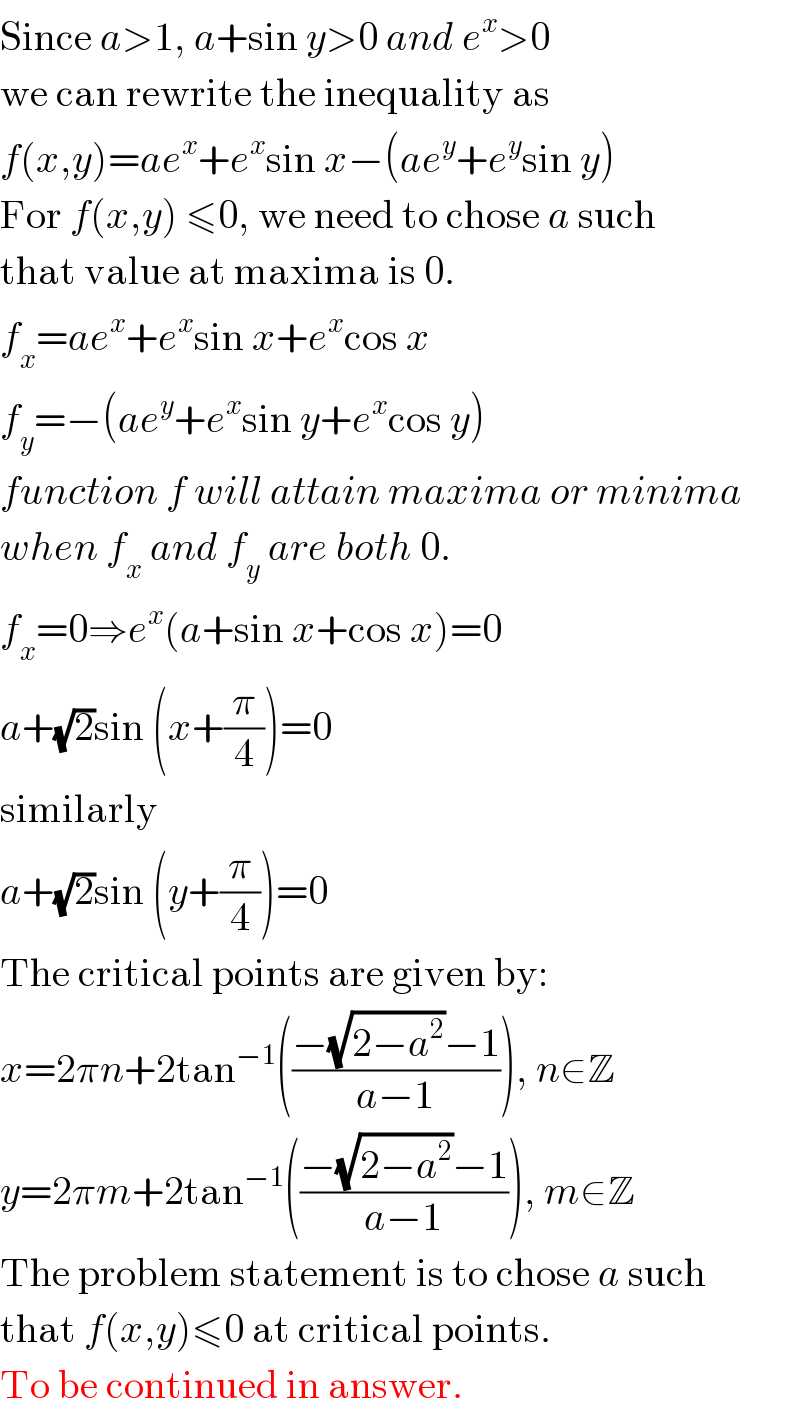
$$\mathrm{Since}\:{a}>\mathrm{1},\:{a}+\mathrm{sin}\:{y}>\mathrm{0}\:{and}\:{e}^{{x}} >\mathrm{0} \\ $$ $$\mathrm{we}\:\mathrm{can}\:\mathrm{rewrite}\:\mathrm{the}\:\mathrm{inequality}\:\mathrm{as} \\ $$ $${f}\left({x},{y}\right)={ae}^{{x}} +{e}^{{x}} \mathrm{sin}\:{x}−\left({ae}^{{y}} +{e}^{{y}} \mathrm{sin}\:{y}\right) \\ $$ $$\mathrm{For}\:{f}\left({x},{y}\right)\:\leqslant\mathrm{0},\:\mathrm{we}\:\mathrm{need}\:\mathrm{to}\:\mathrm{chose}\:{a}\:\mathrm{such} \\ $$ $$\mathrm{that}\:\mathrm{value}\:\mathrm{at}\:\mathrm{maxima}\:\mathrm{is}\:\mathrm{0}. \\ $$ $${f}_{{x}} ={ae}^{{x}} +{e}^{{x}} \mathrm{sin}\:{x}+{e}^{{x}} \mathrm{cos}\:{x} \\ $$ $${f}_{{y}} =−\left({ae}^{{y}} +{e}^{{x}} \mathrm{sin}\:{y}+{e}^{{x}} \mathrm{cos}\:{y}\right) \\ $$ $${function}\:{f}\:{will}\:{attain}\:{maxima}\:{or}\:{minima} \\ $$ $${when}\:{f}_{{x}} \:{and}\:{f}_{{y}} \:{are}\:{both}\:\mathrm{0}. \\ $$ $${f}_{{x}} =\mathrm{0}\Rightarrow{e}^{{x}} \left({a}+\mathrm{sin}\:{x}+\mathrm{cos}\:{x}\right)=\mathrm{0} \\ $$ $${a}+\sqrt{\mathrm{2}}\mathrm{sin}\:\left({x}+\frac{\pi}{\mathrm{4}}\right)=\mathrm{0} \\ $$ $$\mathrm{similarly} \\ $$ $${a}+\sqrt{\mathrm{2}}\mathrm{sin}\:\left({y}+\frac{\pi}{\mathrm{4}}\right)=\mathrm{0} \\ $$ $$\mathrm{The}\:\mathrm{critical}\:\mathrm{points}\:\mathrm{are}\:\mathrm{given}\:\mathrm{by}: \\ $$ $${x}=\mathrm{2}\pi{n}+\mathrm{2tan}^{−\mathrm{1}} \left(\frac{−\sqrt{\mathrm{2}−{a}^{\mathrm{2}} }−\mathrm{1}}{{a}−\mathrm{1}}\right),\:{n}\in\mathbb{Z} \\ $$ $${y}=\mathrm{2}\pi{m}+\mathrm{2tan}^{−\mathrm{1}} \left(\frac{−\sqrt{\mathrm{2}−{a}^{\mathrm{2}} }−\mathrm{1}}{{a}−\mathrm{1}}\right),\:{m}\in\mathbb{Z} \\ $$ $$\mathrm{The}\:\mathrm{problem}\:\mathrm{statement}\:\mathrm{is}\:\mathrm{to}\:\mathrm{chose}\:{a}\:\mathrm{such} \\ $$ $$\mathrm{that}\:{f}\left({x},{y}\right)\leqslant\mathrm{0}\:\mathrm{at}\:\mathrm{critical}\:\mathrm{points}. \\ $$ $$\mathrm{To}\:\mathrm{be}\:\mathrm{continued}\:\mathrm{in}\:\mathrm{answer}. \\ $$
Answered by prakash jain last updated on 20/Nov/15
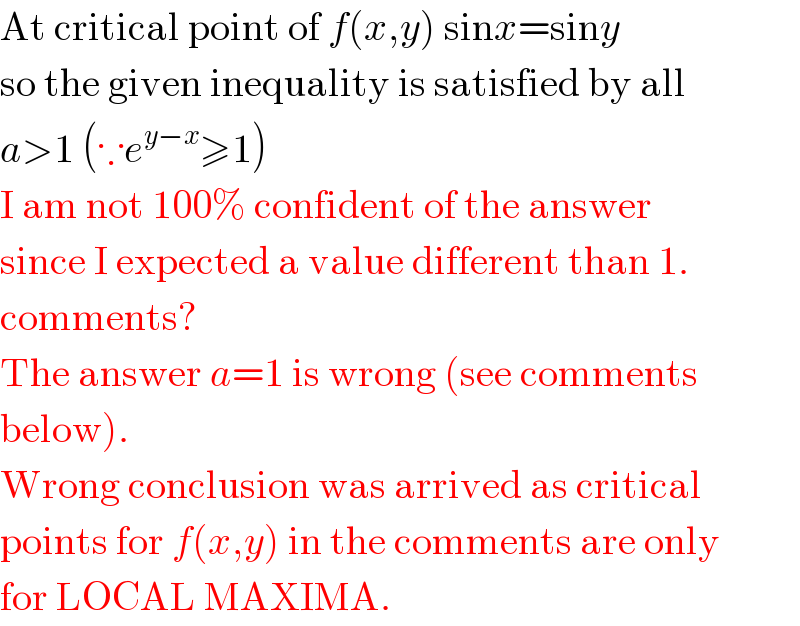
$$\mathrm{At}\:\mathrm{critical}\:\mathrm{point}\:\mathrm{of}\:{f}\left({x},{y}\right)\:\mathrm{sin}{x}=\mathrm{sin}{y} \\ $$ $$\mathrm{so}\:\mathrm{the}\:\mathrm{given}\:\mathrm{inequality}\:\mathrm{is}\:\mathrm{satisfied}\:\mathrm{by}\:\mathrm{all} \\ $$ $${a}>\mathrm{1}\:\left(\because{e}^{{y}−{x}} \geqslant\mathrm{1}\right) \\ $$ $$\mathrm{I}\:\mathrm{am}\:\mathrm{not}\:\mathrm{100\%}\:\mathrm{confident}\:\mathrm{of}\:\mathrm{the}\:\mathrm{answer} \\ $$ $$\mathrm{since}\:\mathrm{I}\:\mathrm{expected}\:\mathrm{a}\:\mathrm{value}\:\mathrm{different}\:\mathrm{than}\:\mathrm{1}. \\ $$ $$\mathrm{comments}? \\ $$ $$\mathrm{The}\:\mathrm{answer}\:{a}=\mathrm{1}\:\mathrm{is}\:\mathrm{wrong}\:\left(\mathrm{see}\:\mathrm{comments}\right. \\ $$ $$\left.\mathrm{below}\right).\: \\ $$ $$\mathrm{Wrong}\:\mathrm{conclusion}\:\mathrm{was}\:\mathrm{arrived}\:\mathrm{as}\:\mathrm{critical} \\ $$ $$\mathrm{points}\:\mathrm{for}\:{f}\left({x},{y}\right)\:\mathrm{in}\:\mathrm{the}\:\mathrm{comments}\:\mathrm{are}\:\mathrm{only} \\ $$ $$\mathrm{for}\:\mathrm{LOCAL}\:\mathrm{MAXIMA}.\: \\ $$
Commented byYozzi last updated on 20/Nov/15
![I′m unsure about how to tackle the problem, but how about this. If x=y the inequality becomes ((a+sinx)/(a+sinx))≤e^0 . ∵ a>1 ⇒∄x,a∈R∣a+sinx=0. So 1≤1 and hence the inequality holds. In this case there isn′t any smallest a∈R since one can infinitely set a to be a value above 1 and very close to 1. No highest lower bound exists for the set {a∈R∣a>1}. For y>x⇒y−x>0⇒e^(y−x) >e^0 =1 ∴1−e^(y−x) <0. Keeping note of this we have ((a+sinx)/(a+siny))≤e^(y−x) [a+sinx,a+siny>0 ∵ a>1] a+sinx≤ae^(y−x) +e^(y−x) siny a(1−e^(y−x) )≤e^(y−x) siny−sinx ⇒a≥((e^(y−x) siny−sinx)/(1−e^(y−x) )) [1−e^(y−x) <0] a≥((e^(y−x) siny)/(1−e^(y−x) ))−((sinx)/(1−e^(y−x) )) (∗) If the RHS of the inequality above is strictly greater than 1 then the smallest a possible would be found to be a=((e^(y−x) siny−sinx)/(1−e^(y−x) )). If this is true then ((e^(y−x) siny−sinx)/(1−e^(y−x) ))>1 e^(y−x) siny−sinx<1−e^(y−x) e^(y−x) (siny+1)<1+sinx If siny+1≠0 (otherwise siny+1>0) ∴e^(y−x) <((1+sinx)/(1+siny)) Checking that this is obeyed by the proposed value for a ((((e^(y−x) siny−sinx)/(1−e^(y−x) ))+sinx)/(((e^(y−x) siny−sinx)/(1−e^(y−x) ))+siny))≤e^(y−x) ((e^(y−x) siny−sinx+sinx−e^(y−x) )/(e^(y−x) siny−sinx+siny−e^(y−x) siny))≤e^(y−x) ((e^(y−x) (siny−1))/(siny−sinx))≤e^(y−x) ((siny−1)/(siny−sinx))≤1. y>x so siny≠sinx. If siny>sinx siny−1≤siny−sinx⇒sinx≤1 (possible) If siny<sinx⇒siny−1≥siny−sinx sinx≥1 (possible if x=nπ+(−1)^n (π/2)) Together the cases suggest that the inequality holds for all x<y, if siny+1≠0. If the RHS of (∗) is not greater than 1 I don′t know how one could acquire the necessary value for a from the information given. In this case we must have a>1.](Q2467.png)
$${I}'{m}\:{unsure}\:{about}\:{how}\:{to}\:{tackle} \\ $$ $${the}\:{problem},\:{but}\:{how}\:{about} \\ $$ $${this}.\: \\ $$ $${If}\:{x}={y}\:{the}\:{inequality}\:{becomes} \\ $$ $$\frac{{a}+{sinx}}{{a}+{sinx}}\leqslant{e}^{\mathrm{0}} .\:\because\:{a}>\mathrm{1}\:\Rightarrow\nexists{x},{a}\in\mathbb{R}\mid{a}+{sinx}=\mathrm{0}. \\ $$ $${So}\:\:\mathrm{1}\leqslant\mathrm{1}\:{and}\:{hence}\:{the}\:{inequality} \\ $$ $${holds}.\:{In}\:{this}\:{case} \\ $$ $${there}\:{isn}'{t}\:{any}\:{smallest}\:{a}\in\mathbb{R}\:{since} \\ $$ $${one}\:{can}\:{infinitely}\:{set}\:{a}\:{to}\:{be}\:{a}\:{value}\:{above}\:\mathrm{1} \\ $$ $${and}\:{very}\:{close}\:{to}\:\mathrm{1}.\:{No}\:{highest}\:{lower}\:{bound} \\ $$ $${exists}\:{for}\:{the}\:{set}\:\left\{{a}\in\mathbb{R}\mid{a}>\mathrm{1}\right\}. \\ $$ $$ \\ $$ $${For}\:{y}>{x}\Rightarrow{y}−{x}>\mathrm{0}\Rightarrow{e}^{{y}−{x}} >{e}^{\mathrm{0}} =\mathrm{1} \\ $$ $$\therefore\mathrm{1}−{e}^{{y}−{x}} <\mathrm{0}.\:{Keeping}\:{note}\:{of}\:{this}\:{we} \\ $$ $${have}\: \\ $$ $$\frac{{a}+{sinx}}{{a}+{siny}}\leqslant{e}^{{y}−{x}} \:\:\:\:\:\:\:\left[{a}+{sinx},{a}+{siny}>\mathrm{0}\:\because\:{a}>\mathrm{1}\right] \\ $$ $${a}+{sinx}\leqslant{ae}^{{y}−{x}} +{e}^{{y}−{x}} {siny} \\ $$ $${a}\left(\mathrm{1}−{e}^{{y}−{x}} \right)\leqslant{e}^{{y}−{x}} {siny}−{sinx} \\ $$ $$\Rightarrow{a}\geqslant\frac{{e}^{{y}−{x}} {siny}−{sinx}}{\mathrm{1}−{e}^{{y}−{x}} }\:\:\:\:\:\:\:\left[\mathrm{1}−{e}^{{y}−{x}} <\mathrm{0}\right] \\ $$ $${a}\geqslant\frac{{e}^{{y}−{x}} {siny}}{\mathrm{1}−{e}^{{y}−{x}} }−\frac{{sinx}}{\mathrm{1}−{e}^{{y}−{x}} }\:\:\:\left(\ast\right) \\ $$ $$ \\ $$ $${If}\:{the}\:{RHS}\:{of}\:{the}\:{inequality}\:{above} \\ $$ $${is}\:{strictly}\:{greater}\:{than}\:\mathrm{1}\:{then}\:{the}\: \\ $$ $${smallest}\:{a}\:{possible}\:{would}\:{be}\:{found}\:{to} \\ $$ $${be}\:{a}=\frac{{e}^{{y}−{x}} {siny}−{sinx}}{\mathrm{1}−{e}^{{y}−{x}} }. \\ $$ $${If}\:{this}\:{is}\:{true}\:{then} \\ $$ $$\frac{{e}^{{y}−{x}} {siny}−{sinx}}{\mathrm{1}−{e}^{{y}−{x}} }>\mathrm{1} \\ $$ $${e}^{{y}−{x}} {siny}−{sinx}<\mathrm{1}−{e}^{{y}−{x}} \\ $$ $${e}^{{y}−{x}} \left({siny}+\mathrm{1}\right)<\mathrm{1}+{sinx} \\ $$ $${If}\:{siny}+\mathrm{1}\neq\mathrm{0}\:\:\left({otherwise}\:{siny}+\mathrm{1}>\mathrm{0}\right) \\ $$ $$\therefore{e}^{{y}−{x}} <\frac{\mathrm{1}+{sinx}}{\mathrm{1}+{siny}} \\ $$ $$ \\ $$ $${Checking}\:{that}\:{this}\:{is}\:{obeyed}\:{by}\:{the} \\ $$ $${proposed}\:{value}\:{for}\:{a}\: \\ $$ $$\frac{\frac{{e}^{{y}−{x}} {siny}−{sinx}}{\mathrm{1}−{e}^{{y}−{x}} }+{sinx}}{\frac{{e}^{{y}−{x}} {siny}−{sinx}}{\mathrm{1}−{e}^{{y}−{x}} }+{siny}}\leqslant{e}^{{y}−{x}} \\ $$ $$\frac{{e}^{{y}−{x}} {siny}−{sinx}+{sinx}−{e}^{{y}−{x}} }{{e}^{{y}−{x}} {siny}−{sinx}+{siny}−{e}^{{y}−{x}} {siny}}\leqslant{e}^{{y}−{x}} \\ $$ $$\frac{{e}^{{y}−{x}} \left({siny}−\mathrm{1}\right)}{{siny}−{sinx}}\leqslant{e}^{{y}−{x}} \\ $$ $$\frac{{siny}−\mathrm{1}}{{siny}−{sinx}}\leqslant\mathrm{1}. \\ $$ $${y}>{x}\:{so}\:{siny}\neq{sinx}.\:{If}\:{siny}>{sinx} \\ $$ $${siny}−\mathrm{1}\leqslant{siny}−{sinx}\Rightarrow{sinx}\leqslant\mathrm{1}\:\left({possible}\right) \\ $$ $$ \\ $$ $${If}\:{siny}<{sinx}\Rightarrow{siny}−\mathrm{1}\geqslant{siny}−{sinx} \\ $$ $${sinx}\geqslant\mathrm{1}\:\left({possible}\:{if}\:{x}={n}\pi+\left(−\mathrm{1}\right)^{{n}} \left(\pi/\mathrm{2}\right)\right) \\ $$ $$ \\ $$ $${Together}\:{the}\:{cases}\:{suggest}\:{that}\:{the}\:{inequality}\:{holds} \\ $$ $${for}\:{all}\:{x}<{y},\:{if}\:{siny}+\mathrm{1}\neq\mathrm{0}. \\ $$ $$ \\ $$ $${If}\:{the}\:{RHS}\:{of}\:\left(\ast\right)\:{is}\:{not}\:{greater}\:{than}\:\mathrm{1}\:{I} \\ $$ $${don}'{t}\:{know}\:{how}\:{one}\:{could}\:{acquire} \\ $$ $${the}\:{necessary}\:{value}\:{for}\:{a}\:{from}\:{the} \\ $$ $${information}\:{given}.\:{In}\:{this}\:{case}\:{we} \\ $$ $${must}\:{have}\: \\ $$ $${a}>\mathrm{1}.\: \\ $$ $$ \\ $$
Commented byYozzi last updated on 20/Nov/15
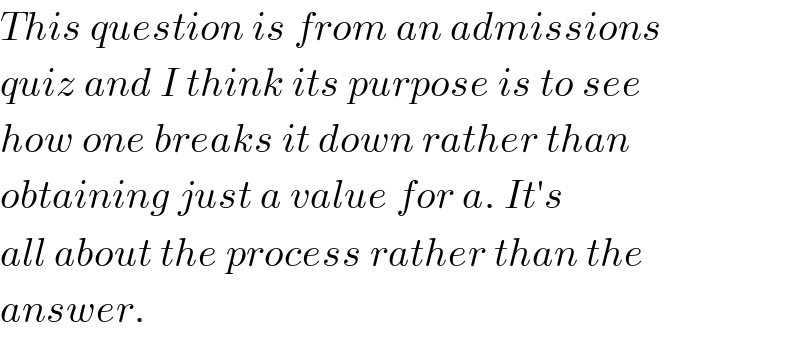
$${This}\:{question}\:{is}\:{from}\:{an}\:{admissions} \\ $$ $${quiz}\:{and}\:{I}\:{think}\:{its}\:{purpose}\:{is}\:{to}\:{see} \\ $$ $${how}\:{one}\:{breaks}\:{it}\:{down}\:{rather}\:{than} \\ $$ $${obtaining}\:{just}\:{a}\:{value}\:{for}\:{a}.\:{It}'{s}\: \\ $$ $${all}\:{about}\:{the}\:{process}\:{rather}\:{than}\:{the} \\ $$ $${answer}. \\ $$
Commented byprakash jain last updated on 20/Nov/15

$$\mathrm{Ok}.\:\mathrm{The}\:\mathrm{answer}\:{a}>\mathrm{1}\:{is}\:{wrong} \\ $$ $$\frac{\mathrm{1}.\mathrm{01}+\mathrm{sin}\:{x}}{\mathrm{1}.\mathrm{01}+\mathrm{sin}\:{y}}\leqslant{e}^{{y}−{x}} \\ $$ $${x}=\frac{\pi}{\mathrm{2}},\:{y}=\frac{\mathrm{3}\pi}{\mathrm{2}} \\ $$ $$\frac{\mathrm{2}.\mathrm{01}}{\mathrm{0}.\mathrm{01}}=\mathrm{201}\nleq{e}^{\pi} \\ $$
Commented byYozzi last updated on 20/Nov/15

$${It}\:{probably}\:{was}\:{as}\:{simple}\:{as}\: \\ $$ $${observing}\:{no}\:{such}\:{a}\:{exists}. \\ $$
Commented byprakash jain last updated on 20/Nov/15
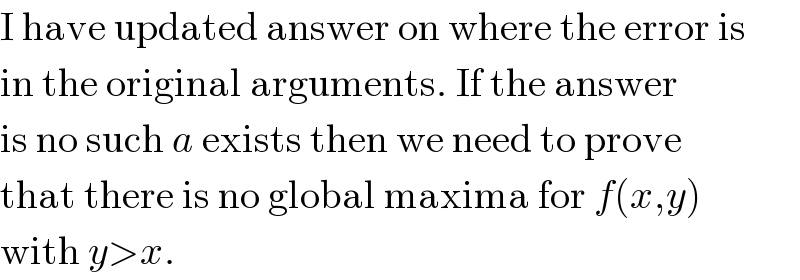
$$\mathrm{I}\:\mathrm{have}\:\mathrm{updated}\:\mathrm{answer}\:\mathrm{on}\:\mathrm{where}\:\mathrm{the}\:\mathrm{error}\:\mathrm{is} \\ $$ $$\mathrm{in}\:\mathrm{the}\:\mathrm{original}\:\mathrm{arguments}.\:\mathrm{If}\:\mathrm{the}\:\mathrm{answer} \\ $$ $$\mathrm{is}\:\mathrm{no}\:\mathrm{such}\:{a}\:\mathrm{exists}\:\mathrm{then}\:\mathrm{we}\:\mathrm{need}\:\mathrm{to}\:\mathrm{prove} \\ $$ $$\mathrm{that}\:\mathrm{there}\:\mathrm{is}\:\mathrm{no}\:\mathrm{global}\:\mathrm{maxima}\:\mathrm{for}\:{f}\left({x},{y}\right) \\ $$ $$\mathrm{with}\:{y}>{x}. \\ $$
Commented byYozzi last updated on 20/Nov/15

$${Yes}.\: \\ $$
